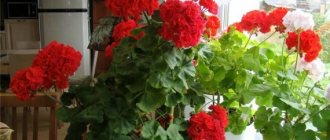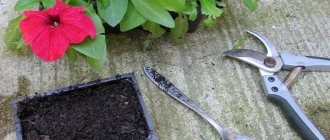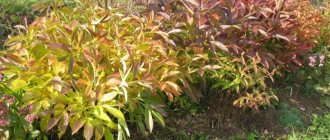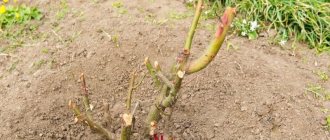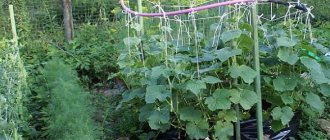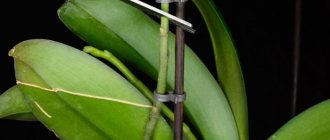How to pinch petunia to make it bloom beautifully
This spectacular flower requires proper care. In order for petunia to form a beautiful bush and delight with impeccable flowering, pinching the petunia is necessary.
Lush petunia bloom
What is the pinching process?
Pinching is the removal of the top part of a young shoot. After removing the central stem of petunia, any of its varieties forms a new growth point and after some time begins to grow in different directions. Due to this procedure, more branches appear on the bush and, accordingly, more flowers.
Pinching can be done easily by hand
What is the benefit of pinching
If you do not pinch and form a young plant, it will produce up to 3 stems, and after a short time of flowering it will lose its beautiful appearance. Soon, an unkempt petunia, under the weight of long stems, presses to the ground and completely loses its aesthetic appearance.
Interesting! The pinching procedure is otherwise called pinching.
Pinching brings visible benefits: the bush grows not in length, but in width, each of the side shoots produces flower buds. A pinched bush develops much more beautifully. Pinching is the main condition for lush and abundant flowering, which is why bushes after pinching attract so much attention.
Do all varieties of petunias need to be pinched?
There is an opinion that only simple varieties need to be pinched, and professional ones should branch on their own. But after pinching both regular and hybrid varieties of petunia, the flowerbed looks more luxuriant. So, for a visual effect, to give impetus to multiple branching, cascading and ampelous varieties are pinched.
Petunia varieties
Be sure to pinch if the following problems arise:
- insufficient lighting, due to which young plants become too elongated;
- excessively high temperature;
- insufficient area with a large number of seedlings.
For petunia, proper care when growing and pinching is very important.
When to do it
Pinching petunias for bushiness should be done when young seedlings grow 6-7 leaves. This period is considered the best for pinching a flower. A correctly carried out procedure guarantees a powerful impetus for the growth of young and strong shoots.
If for some reason you miss this moment, then achieving a spherical shape from a flower will be much more difficult, and sometimes almost impossible. The plant will begin to actively stretch upward and quickly lose its decorative shape.
Important! On overgrown bushes it is impossible to achieve the expected effect from picking.
Dates and rules
During the season, petunia is shortened more than once, since the period of active growth lasts until autumn. Regular pruning helps maintain the decorative appearance of the bush and the abundance of flowering. The timing is chosen according to the stage of development:
- The seedlings are pinched for the first time when 4-6 true leaves have formed. This happens approximately 10-12 days after the dive - the seedling has already taken root and adapted to the new place. The procedure gives impetus to the growth of new shoots, the collection of green mass, and the formation of flower buds. An increase in the volume of greenery, in turn, strengthens the root system, which facilitates rapid adaptation after transplanting into the ground. If the moment is missed, the stems will stretch excessively and it will be difficult to form a beautiful bush.
- After 20-28 days, not only the main stem is shortened, but also all the side shoots that have grown by 10 cm or more - third-order sprouts will appear on them.
- In the future, to maintain the shape of the bush, the stems are cut as needed once a month, but no more than three times per season, since pinching delays the onset of flowering.
- During the season, faded flowers are plucked off so that the plant does not waste energy on the formation and ripening of seeds.
Related article:
Small chamomile in the garden
To ensure that the procedure does not cause harm, you must not only adhere to the deadlines, but also follow the rules for its implementation - then the stress will be minimal, and the petunia will quickly recover. It is better not to touch a weak bush, but wait until it gets stronger. If you delay pruning, removing most of the young bush will lead to its weakening or death.
On a note! How to plant petunia with cuttings
How to pinch correctly:
- treat the tools used for pruning (small scissors, knife) with a solution of manganese or alcohol, chlorhexidine;
- count four leaves from the bottom, cut off the rest of the stem;
- make the cut at a right angle - the shoots will not grow upward, but to the sides, and flower buds will form on them;
- Sprinkle the cut area with coal powder, ash, and baby powder.
Related article:
15 types of Dubrovnik for your garden: Description and secrets of cultivation
How to properly pinch petunia for abundant flowering
How to feed hydrangea in spring for lush flowering in the garden
Trimming the top of the stem of a young petunia will allow the plant to vigorously begin to grow and bloom spectacularly. You need to pinch the petunia several times. It is important to take into account that the first pinching is the most important, and it is carried out at the seedling stage.
You need to remove shoots not with your hands, but with scissors
Pinching by hand is not recommended, as there is a risk of damaging the integrity of the stem, which can subsequently lead to rotting and loss of the entire plant. You need to trim the young stem with scissors, a sharp blade or a knife. Mature stems can be removed using pruning shears.
The first pinch when growing petunia from seeds
When young petunia seedlings have grown up, many people have a question about how to properly pinch petunia. Start pinching a plant in a pot as early as possible. It is better to start the procedure when the number of leaves is from 4 to 7 pieces. This happens approximately 2 months after the formation of seedlings.
This procedure is carried out to stimulate the growth of lateral dormant buds on the stem. After properly pinching the remaining leaves from the axil, new young shoots begin to grow upward and to the sides. Each pruning is carried out not only to form a bush, but also to produce abundant flowering. It is advisable to do this at least once a month.
Advice! If necessary, the “pinching” procedure is carried out several times to achieve the required density of the bush.
What to do after pinching
After pinching the plant, the young flower actively grows green mass, and for good growth it will need nutrients. Therefore, it is necessary to fertilize with fertilizers.
Is it possible to pinch petunia when it blooms?
Pinching for lush and long flowering of petunia is carried out more than once. It is necessary to pinch the plant not only when forming a bush, but also during flowering.
If an adult petunia bush begins to lose its neat shape, it is necessary to trim the side shoots again. And the plant will again direct all its forces to flowering, releasing new flower buds.
Pinching a blooming petunia
How to shape petunia so that it bushes beautifully
It is necessary to form a young plant on time so that it bushes beautifully. You cannot postpone the operation until later and cut off half of the young bush at once. Instead of growing, the plant will suffer for a long time from such a careless approach, and may even die. Therefore, in one approach, you cannot remove more than one-fifth of the green mass of the entire bush of a young plant.
What does pinching do?
Pinching (the scientific term is pinching) is a procedure in which the apical part of the shoot and apical buds are removed by breaking off and cutting. Many types of ornamental plants need pinching to add splendor and form a beautiful compact bush.
Related article:
5 most beautiful flowers that will decorate your garden in the fall
Benefits of pruning:
- a balance is created between the underground and above-ground parts;
- nutrients are distributed evenly;
- the development of side shoots is more intense;
- The buds are larger, the flowers are more saturated in color.
After removing the top of the main stem of the petunia, new shoots begin to grow from the leaf axils, which, if necessary, are also shortened in the future. If the stem is not cut, then, having stretched out, it falls under its own weight, it has to be tied up, which affects the decorative effect, and fewer flowers are formed.
Pinching does not last long, but delays flowering. This feature is specially used in cases where it is necessary for all the flowers in the flowerbed to bloom at the same time.
Features of the formation of different types of petunia
There are four most popular types of petunias: ampelous, bush, cascading, terry. The principles and features of the formation of each type are different.
Ampelnaya
Geranium - pruning for lush flowering so that it blooms and is fluffy
This type is popular when landscaping streets in hanging flowerpots and balconies. Petunia of ampelous varieties grows long, flowing shoots. Due to the stems creeping along the ground, it is not popular in flower beds.
Ampelous varieties are pinched so that they actively grow lateral shoots. The step-by-step formation scheme is different; the rules of the “third pair” of leaves do not apply to this type of petunia.
Important! The central stem of the plant is pinched when its length reaches 10 cm. Otherwise, the middle of the bush will look empty.
Cascade
Hybrid varieties and varieties belonging to this category bush themselves and grow shoots in all directions up to 70 cm long. Some side shoots can even reach 1 meter.
How to form petunia: pinching is carried out if the variety is growing too quickly, and it is too early to replant it in a permanent place. However, among flower growers, an opinion has formed that any hybrid varieties need to be pinched. After pinching, they look much more impressive.
Bush
Most bush petunias do not require pinching. Tweezing is carried out if there are few side shoots and it needs to be “incited”. If the central stem has grown too high, it is also pinched.
Terry
Experienced gardeners advise be sure to pinch the shoots of terry petunia. Then the bushes form many buds. After the buds bloom, it is necessary to monitor the plant and pluck faded flowers in a timely manner.
Important! In cold and very rainy summers, ampelous and cascading varieties are pinched out, fearing the appearance of fungal diseases due to the bush being too thick.
Features of pinching petunias in pots and cache-pots
Petunia is so attractive with its abundant and bright blooms that it is often grown in pots and flowerpots to decorate home interiors. In the same way, they bring beauty to the recreation area at the dacha and the summer cafe. They decorate balconies, loggias, and terraces, creating amazing compositions of flowers of different colors.
To achieve the original appearance of a flower grown in pots and cache-pots, the crown is formed, and this involves pinching the side shoots.
The number of plants planted in individual containers depends on their size. So, with a diameter of 30 cm, 2-3 plants will be enough, which, after pinching, will grow and fill the entire space.
On a note. Be careful: excessive thickening can lead to the emergence of foci of infection due to insufficient ventilation.
As a rule, petunia bushes are planted in a pot (plant pot), which have already been pinched once at a “young” age, and now they are actively producing side shoots. Be creative with the pruning procedure and give the flower the shape you like. It depends only on the grower how long he wants to see the petunia shoots cascading down in a bright and colorful waterfall.
The fact is that the stems of ampelous and cascading petunias can grow up to 80 centimeters or more, and if their growth is not inhibited, then over time the lower part will become bare and the plant will lose its decorative effect. To prevent this from happening, the stems are regularly pruned, which encourages the plant to grow and develop side shoots.
The height of the flowerpot may also be the reason for the need for pruning. It is unlikely that a gardener will want a flower to spread along the windowsill or the ground, taking up useful space and complicating the care of the plant.
What varieties of petunias are pinched?
How to plant ampelous petunia correctly
Petunia pruning to form a bush must be carried out in ordinary varieties, not hybrid ones. Gardeners love them not for the unusual color of the flowers, but for their delicate sweet aroma. Cascading and ampel varieties, pinch for lush flowering. But an ordinary bush without pinching, if not pinched, will turn out shapeless and even clumsy.
Important! Hybrid varieties usually strive for beautiful shapes themselves, but after pinching they look curly and more luxuriant.
Petunias: description and characteristics of the plant
Petunia is a flowering herbaceous plant that is characterized by unpretentiousness and lush flowering. It has the shape of a bush, which is abundantly strewn with a large number of small flowers. The color of the inflorescences, depending on the variety, can be varied: white, purple, red, blue, pink, etc. Some hanging bushes are characterized by double color.
Petunia
Please note: breeders have recently developed new varieties of petunias, which are rapidly gaining popularity. Their characteristic feature is the formation of spectacular double inflorescences.
To successfully grow the crop, you need to know how to trim petunia, water it regularly and provide the plant with plenty of light. It is important that growing plants in nearby flower beds do not shade or “press” the petunia. If you neglect this rule, the bush will stretch out and no improvement can be achieved through shaping; the color will be small.
In order for flowering to be lush and long-lasting, the plant must be fed with mineral or organic fertilizers. The optimal number of applications during the growing season is 3. To prevent the development of diseases and pest attacks, it is recommended to regularly irrigate the bushes with fungicide solutions.
Petunia bushes
In order for the bushes to bloom again, have an attractive shape and be healthy, they must be pruned regularly.
At what length of shoot should pinching be carried out?
50-60 days after germination, the length of young seedlings usually reaches 7-10 cm. By this time, 3 pairs of leaves have already grown on the plant. To make the correct pinching, both for the formation of a bush and for abundant flowering, it is necessary to pinch off the tip of the shoot. Do not cut off the growth point above the very top leaf with sharp scissors. You should not pick off the plant, so as not to injure the delicate stem.
The second pinching procedure is carried out approximately a month later. At this time, the side shoots grow, so carefully pinch them off.
Important! Pinching must be carried out in the upper part of the shoots so as not to touch the already formed buds.
Petunia with side shoots
Pinching petunias
Pinching petunias: why do it and when...
Voluminous multi-colored bushes of double, ampelous, bicolor and single-color petunias have won the hearts of experienced gardeners and beginners. From mid-spring until the first frost, flowers of amazing variety and decorativeness decorate not only summer cottages, but also the balconies of multi-storey buildings, verandas of cottages, city flower beds, cafes and restaurants. The flowers are unpretentious, do not require professional maintenance or special conditions, but they respond favorably to the care of flower growers.
Necessary conditions for pinching petunia How to pinch petunia Helpful tips How to pinch petunia correctly (video)
Necessary conditions for pinching petunia
Proper cultivation and formation is an important condition for obtaining a beautiful and healthy bush. In addition to timely sowing and picking, it is necessary to properly pinch the petunia. This means that at a certain stage of growth it needs to remove the top shoots. This procedure will ensure branching of the stems and the formation of many buds on bushy crowns.
To carry out this manipulation you will need the following:
convenient scissors or pruning shears; strong seedlings with 4 - 5 large leaves at the top; container for collecting removed cuttings.
How to pinch petunia
Before pinching petunia, it is advisable to familiarize yourself with the basic requirements for this procedure.
When observing the growth of seedlings, it is necessary to choose a period when they have become a little stronger and began to quickly grow upward.
It can have up to 5 - 6 leaves, but no more. If you miss this moment, the seedlings will stretch out. Actually pinching the petunias will not take much time. It is necessary to trim the stem above 5-6 leaves using your fingers or pruning shears. This forms a new growth point, from which several shoots will begin to grow simultaneously in different directions. During this period, the seedlings may slow down their development, but at the same time they will become a little stronger. When side shoots begin to appear, the bush will take on a more rounded appearance. If you plan to plant seedlings in open ground, then it is better to pinch them after rooting. The sprout will need several days to adapt. During this period, you need to try to create favorable conditions for the plants to take root:
seedlings need to be planted loosely, observing the conditions of agricultural technology; monitor the frequency of watering and spraying; Apply a specialized strengthening fertilizer to the roots.
If development occurs in a greenhouse, you can pinch the petunia after picking.
If the cut shoots are not very small, they can be used as cuttings. In order for the cutting to take root, it is placed in a container of water. First you need to remove excess leaves, leaving a few at the top. When the roots appear, they are transplanted into the soil. This way you can get additional young seedlings.
Useful tips
when pinching, try to injure the sprout as little as possible, use clean tools; a month after the event and the appearance of strong side branches, pinching the tops of the petunias can be repeated; To plant large buds on new stepsons, use suitable fertilizers; they will make the flowers brighter and larger.
In order for a formed ornamental bush to please with its beautiful appearance for as long as possible, it will need constant care. From the moment of sowing, no replanting, pinching, or spraying of sprouts will be required. Do not forget to water and feed well, remove dried flowers and shoots. In place of the cut old flowers, new branches with buds will appear. Well-groomed colorful petunias will undoubtedly delight you with abundant and long flowering.
How to properly pinch petunia (video)
Is it possible to pinch petunia when it blooms?
Blooming petunia is also pinched to form a beautiful bush. If you buy a young plant at the market, then first inspect it and remove all wilted flowers, always with the receptacle.
The procedure is quite simple. Doubts may arise only in the question of how to pinch petunia if the stem is too long. In this case, it is pinched, leaving 3 pairs of leaves. Flowering will slow down for some time, but soon a large number of flowers will bloom on the newly formed branches.
Important! On a flowering plant, you can cut 2-3 shoots at a time. After pinching the bush, it is necessary to feed it with fertilizer.
Frequent mistakes of flower growers
Beginning flower growers can make many mistakes. Let's look at some of them:
- Frail seedlings. If you pinch weak, immature seedlings that have not yet taken root well, they look lethargic. In this case, you need to wait a little, creating favorable conditions for the plant: adding artificial lighting or adding the missing fertilizer. It is possible that the soil does not meet the needs of this plant. We need to find out the cause and eliminate it.
- Processing with one instrument without subsequent sterilization. You can easily introduce spores of pathogenic fungi or other diseases.
- It happens that something was overlooked and one shoot quickly stretched out and even a bud came out, no big deal, you just need to pinch the shoot over the third pair of leaves. The flower must be removed without pity; in its place more flowers and even larger ones will appear.
- Early pinching. If the plant has not yet formed 5-6 leaves, pinching will not have the best effect. Because after pinching, the remaining stem will become woody and many dormant buds will awaken. A young plant may not be able to cope with such a load and will simply die.
- There is an opinion that hybrids do not need to be pinched. But if they grew in unfavorable conditions for them, then in order to form a beautiful bush they will still need to be pinched.
Caring for flowers after pinching
Petunia needs care, but growing and pinching it does not require special skills - the gardener will only need patience and attention. After pinching, you need to promptly provide the plant with additional nutrition and proper care.
In addition to feeding the flower with fertilizers, you need to organize proper watering. In summer, the branches are watered twice in the morning, when the scorching sun has not yet risen. And then - in the evening, when the sun's heat subsides a little.
After pinching a petunia, the plant grows side shoots twice as fast, spending a lot of nutrients on this. To replenish their supply, the flower is fed. Flower growers recommend spraying the flower with succinic acid after pinching. And fertilize with complex mineral fertilizers.
To replenish the supply of micro- and macroelements, the following drugs are suitable:
- complex products with the inscription “For petunia”;
- nitroammophoska;
- succinic acid;
- complex fertilizers “For flowering plants”.
If you do not feed the flower after pinching, the new side shoots will be weak and the expected result will not be obtained.
For a comprehensive effect, you can also use homemade fertilizers:
- Infused water with fresh banana peels. This water is rich in potassium and nitrogen, which allows you to grow good leaf mass.
- Ash. It is sprinkled on the plant at the roots.
- Chicken droppings are infused and diluted, and the plant is watered with this solution. After this fertilizer, the flower will bloom well.
- Pressed yeast. To do this, you need only 50 g of yeast per bucket of warm water. After stirring the solution well, it is left to infuse for 3-4 hours. The resulting solution is diluted in the following ratio: a half-liter jar of solution per bucket of warm water - and the bushes are watered.
After proper feeding, the plants quickly increase their green mass, and the root system also grows quickly. However, it is important to consider that it is better not to water these flowers with cold water.
Important! All fertilizers are applied to moist soil, otherwise the root system can be damaged.
Some useful tips
In order for the plant to bloom as long as possible, you cannot limit yourself to just pinching. Do not forget about the following subtleties of care:
1. It is necessary to remove all wilted and completely faded buds from the plant. Because if you leave them, the petunia will be forced to spend all its energy on ripening the seed pod.
2. The plant must be fed.
3. If daytime temperatures are too high, then the flower bushes should be sprayed with a spray bottle. But the procedure can only be carried out early in the morning and in the evening, when the sun's rays are no longer so active. Otherwise, the plant will get burned and may die.
And remember that every pinching is stress for the petunia, which it must endure. That is why after each procedure the bushes freeze slightly, but respond with increased growth of side shoots and the formation of larger buds.
sovetysadovodam.ru
What to do with cuttings after pruning
Cuttings plucked from the mother bushes convey all varietal characteristics. With their help, you can additionally propagate expensive varieties. The pinched off shoots will grow and with good care, like other bushes, can form an abundant flowering cap.
Petunia cuttings taking root in the ground
The cut cuttings are cleared of the lower leaves and placed in water for rooting. After 10 days, the plant begins to sprout roots, and then it is planted in a loose substrate of nutritious soil and a baking powder, such as sand or vermiculite.
The removed shoot can be planted directly into the substrate. For better and faster rooting, use “Kornevin”. The cuttings are treated with a stimulant, then planted in loose soil and lightly watered.
Petunia is a beauty; with good and attentive care, she is not at all capricious. By following a simple care guide, it is very easy to achieve lush flowering with a cap!
Using cut tops
The apical part of the stem will make an excellent cutting for propagating your favorite variety. This is especially true when growing petunias indoors.
What to do:
- on the trimmed shoot, three lower nodes are left, each of which has a pair of leaves, the rest is removed;
- pour water into a glass, add a few drops of growth stimulator and place the cutting in it;
- the root system will form in 14-21 days;
- the seedling is planted in the ground.
Related article:
Rules for planting dahlias
Rule 5. When to fertilize
| What and when to feed petunia Before sowing Soak in a solution of growth stimulator “Epin” or “Zircon”. To do this, pipette the solution into a small container and pour in the seeds. Leave for 24 hours. After the pick After two weeks, fertilize with any flower fertilizer. Then fertilize once every 2-3 weeks. After pinching Be sure to add nitrogen-phosphorus supplements with microelements. For the formation and growth of lateral sprouts, the plant requires strength. Apply the fertilizer solution periodically instead of regular watering. During bud formation and flowering The flower needs potassium-phosphorus supplements. A good option, for example, is “Fertika Lux” or “Kemira Lux” |
